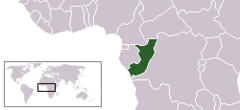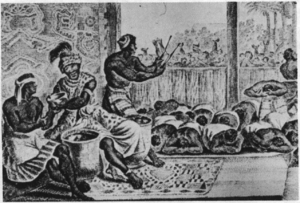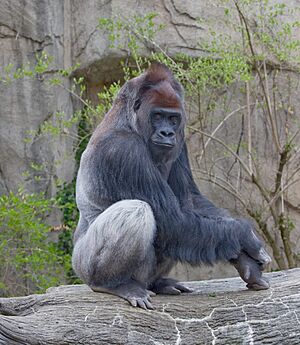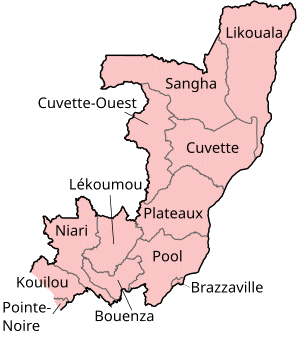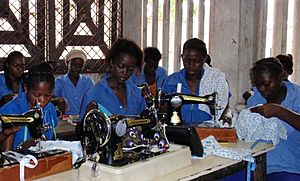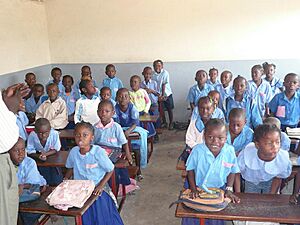Republic of the Congo facts for kids
Quick facts for kids
Republic of the Congo
|
|
|---|---|
|
|
|
|
Motto: "Unité, Travail, Progrès"
"Unity, Work, Progress" |
|
|
Anthem: "La Congolaise"
Besi Kôngo "The Congolese" |
|
| Capital and largest city
|
Brazzaville 4°16′S 15°17′E / 4.267°S 15.283°E |
| Official languages | French |
| Recognised national languages |
|
| Religion
(2020)
|
|
| Demonym(s) |
|
| Government | Unitary semi-presidential republic under a dominant-party authoritarian state |
| Denis Sassou Nguesso | |
| Anatole Collinet Makosso | |
| Legislature | Parliament |
| Senate | |
| National Assembly | |
| Independence | |
|
• Republic established
|
28 November 1958 |
|
• from France
|
15 August 1960 |
| Area | |
|
• Total
|
342,000 km2 (132,000 sq mi) (64th) |
|
• Water (%)
|
3.3 |
| Population | |
|
• 2023 estimate
|
6,228,784 (116th) |
|
• 2023 census
|
6,142,180 |
|
• Density
|
17.96/km2 (46.5/sq mi) |
| GDP (PPP) | 2023 estimate |
|
• Total
|
|
|
• Per capita
|
|
| GDP (nominal) | 2023 estimate |
|
• Total
|
|
|
• Per capita
|
|
| Gini (2011) | 40.2 medium |
| HDI (2022) | medium · 149th |
| Currency | Central African CFA franc (XAF) |
| Time zone | UTC+1 (WAT) |
| Date format | dd/mm/yyyy |
| Driving side | right |
| Calling code | +242 |
| ISO 3166 code | CG |
| Internet TLD | .cg |
The Republic of the Congo is a country in Africa. Its capital city is Brazzaville. The country was a former colony of France; it became independent on 15 August 1960. The north of the country has very large areas of rainforest, but in the south are many farms which grow bananas, peanuts and other crops.
Contents
History
Bantu-speaking peoples who founded tribes during the Bantu expansions, mostly displaced and absorbed the earlier inhabitants of the region, the Pygmy people, about 1500 BC. The Bakongo, a Bantu ethnic group that occupied parts of what later became Angola, Gabon, and the Democratic Republic of the Congo, formed the basis for ethnic affinities and rivalries among those countries.
By the 13th century, there were three main confederations of states in the western Congo Basin. In the east were the Seven Kingdoms of Kongo dia Nlaza, considered to be the oldest and most powerful, which likely included Nsundi, Mbata, Mpangu, and possibly Kundi and Okanga. South of these was Mpemba which stretched from modern-day Angola to the Congo River. It included various kingdoms such as Mpemba Kasi and Vunda. To its west across the Congo River was a confederation of three small states; Vungu (its leader), Kakongo, and Ngoyo. Some Bantu kingdoms—including those of the Kongo, the Loango, and the Teke—built trade links leading into the Congo Basin.
The Portuguese explorer, Diogo Cão reached the mouth of the Congo in 1484. Commercial relationships grew between the inland Bantu kingdoms and European merchants who traded in commodities, manufactured goods, and people captured and enslaved in the hinterlands. After centuries as a central hub for transatlantic trade, direct European colonization of the Congo River delta began in the 19th century, subsequently eroding the power of the Bantu societies in the region.
The area north of the Congo River came under French sovereignty in 1880 as a result of Pierre de Brazza's treaty with King Makoko of the Bateke. After the death of Makoko, his widow Queen Ngalifourou upheld the terms of the treaty and became an ally to the colonizers. This Congo Colony became known first as French Congo, then as Middle Congo in 1903.
In 1908, France organized French Equatorial Africa (AEF), comprising the Middle Congo, Gabon, Chad, and Oubangui-Chari (which later became the Central African Republic). The French designated Brazzaville as the federal capital. Economic development during the first 50 years of colonial rule in Congo centered on natural resource extraction. Construction of the Congo–Ocean Railway following World War I has been estimated to have cost at least 14,000 lives.
During the Nazi occupation of France during World War II, Brazzaville functioned as the symbolic capital of Free France between 1940 and 1943. The Brazzaville Conference of 1944 heralded a period of reform in French colonial policy. Congo "benefited" from the postwar expansion of colonial administrative and infrastructure spending as a result of its central geographic location within AEF and the federal capital at Brazzaville. It had a local legislature after the adoption of the 1946 constitution that established the Fourth Republic.
Following the revision of the French constitution that established the Fifth Republic in 1958, AEF dissolved into its constituent parts, each of which became an autonomous colony within the French Community. During these reforms, Middle Congo became known as the Republic of the Congo in 1958 and published its first constitution in 1959. Antagonism between the Mbochis (who favored Jacques Opangault) and the Laris and Kongos (who favored Fulbert Youlou, the first black mayor elected in French Equatorial Africa) resulted in a series of riots in Brazzaville in February 1959, which the French Army subdued.
Elections took place in April 1959. By the time the Congo became independent in August 1960, Opangault, the former opponent of Youlou, agreed to serve under him. Youlou, an avid anti-communist, became the first President of the Republic of the Congo. Since the political tension was so high in Pointe-Noire, Youlou moved the capital to Brazzaville.
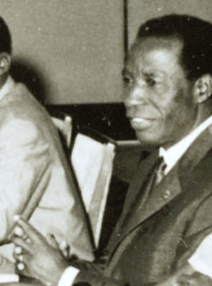
The Republic of the Congo became fully independent from France on 15 August 1960. It was a Marxist–Leninist state from 1969 to 1992, under the name People's Republic of the Congo (PRC). The country has had multi-party elections since 1992, but a democratically elected government was ousted in the 1997 Republic of the Congo Civil War. President Denis Sassou Nguesso, who first came to power in 1979, ruled until 1992 and then again since after his reinstatement.
Geography
Natural landscapes range from the savanna plains in the North Niari flooded forests, to the Congo River, to the rugged mountains and forests of Mayombe, and 170 km of beaches along the Atlantic coast.
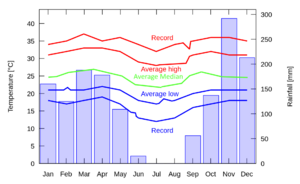
Congo is located in the central-western part of sub-Saharan Africa, along the Equator, lying between latitudes 4°N and 5°S, and longitudes 11° and 19°E. To the south and east of it is the Democratic Republic of the Congo. It is bounded by Gabon to the west, Cameroon and the Central African Republic to the north, and Cabinda (Angola) to the southwest. It has a coast on the Atlantic Ocean.
The southwest is a coastal plain for which the primary drainage is the Kouilou-Niari River; the interior of the country consists of a central plateau between 2 basins to the south and north. Forests are under increasing exploitation pressure. Congo had a 2018 Forest Landscape Integrity Index mean score of 8.89/10, ranking it 12th globally out of 172 countries.
Congo lies within 4 terrestrial ecoregions: Atlantic Equatorial coastal forests, Northwestern Congolian lowland forests, Western Congolian swamp forests, and Western Congolian forest–savanna mosaic. Since the country is located on the Equator, the climate is more consistent year-round, with the average day temperature a humid 24 °C (75 °F) and nights generally between 16 °C (61 °F) and 21 °C (70 °F). The average yearly rainfall ranges from 1,100 millimetres (43 in) in the Niari Valley in the south to over 2,000 millimetres (79 in) in central parts. The dry season is from June to August, while in the majority of the country, the wet season has 2 rainfall maxima: 1 in March–May and another in September–November.
In 2006–07, researchers from the Wildlife Conservation Society studied gorillas in "heavily forested" regions centered on the Ouesso District of the Sangha Region. They suggest a population on the order of 125,000 western lowland gorillas whose isolation from humans has been mostly preserved by "inhospitable" swamps.
Biodiversity
The Republic of the Congo is home to approximately 10,000 species of tropical plants. Among which thirty percent (3,000) of these species are specific to Congo. Congo plants include some of the most diverse and rich environments and the largest forest areas, with only the Democratic Republic of the Congo being more diverse. There are about 6,000 plant species in the country.
Around 2008, researchers from the Wildlife Conservation Society studied gorillas in heavily forested regions centered on the Ouesso district of the Sangha Region. They suggested a population on the order of 125,000 western lowland gorillas (Gorilla gorilla gorilla), whose isolation from humans has been largely preserved by inhospitable swamps.
Government and politics
The government of the Republic is a semi-presidential system with an elected president who appoints the Council of Ministers, or Cabinet. The council, including the Prime Minister, is selected from the elected representatives in Parliament. Since the 1990s, the country has had a multi-party political system which is dominated by President Denis Sassou Nguesso. Sassou Nguesso is backed by his own Congolese Labour Party (Parti Congolais du Travail) as well as a range of smaller parties.
On 27 March 2015, Sassou Nguesso announced that his government would hold a referendum on changing the country's 2002 constitution to allow him to run for a third consecutive term in office. On 25 October, the government held a referendum on allowing Sassou Nguesso to run in the next election. The government claimed that the proposal was approved by 92% of voters, with 72% of eligible voters participating. The opposition who boycotted the referendum said that the government's statistics were false and the vote was a fake one. The election raised questions and was accompanied by civil unrest and police shootings of protesters; at least 18 people were killed by security forces during opposition rallies leading up to the referendum held in October.
Administrative divisions
It is divided into 12 départements (departments). Departments are divided into communes and districts. These are:
Economy
The economy is a mixture of village agriculture and handicrafts, an industrial sector based mainly on petroleum, support services, and a government characterized by budget problems and "overstaffing". Petroleum extraction has supplanted forestry as the mainstay of the economy. In 2008, the oil sector accounted for 65% of the GDP, 85% of government revenue, and 92% of exports. The country has untapped mineral wealth.
In the 1980s, rising oil revenues enabled the government to finance larger-scale development projects. GDP grew an average of 5% annually. The government has mortgaged a portion of its petroleum earnings, contributing to a "shortage of revenues". On 12 January 1994, the devaluation of Franc Zone currencies by 50% resulted in an inflation of 46% in 1994, and inflation has subsided since.
Economic reform efforts continued with the support of international organizations, including the World Bank and the International Monetary Fund. The reform program came to a halt in June 1997 when civil war erupted. When Sassou Nguesso returned to power in October 1997, he publicly expressed interest in moving forward on economic reforms and privatization and in renewing cooperation with international financial institutions. Economic progress was "badly hurt" by slumping oil prices and the resumption of armed conflict in December 1998, which "worsened" the republic's budget deficit.
The administration presides over an "uneasy internal peace" and faces "difficult" economic problems of stimulating recovery and reducing poverty, with record-high oil prices since 2003. Natural gas and diamonds are other exports, while Congo was excluded from the Kimberley Process in 2004 amid allegations that most of its diamond exports were, in fact, being smuggled out of the neighboring Democratic Republic of the Congo; it was re-admitted to the group in 2007.
The Republic of the Congo has untapped base metal, gold, iron, and phosphate deposits. It is a member of the Organization for the Harmonization of Business Law in Africa (OHADA). The Congolese government signed an agreement in 2009 to lease 200,000 hectares of land to South African farmers to reduce its dependence on imports. The GDP of the Republic of the Congo grew by 6% in 2014 and is expected to have grown by 7.5% in 2015.
In 2018, the Republic of the Congo joined the Organization of Petroleum Exporting Countries.
Congo–Ocean Railway was built by forced laborers during the 1930s. Some colonial architectural heritage is preserved. Restoration of architectural works is underway in Brazzaville, for example, at the Basilica of Sainte-Anne du Congo, which was completed in 2011.
Demographics
| Year | Million |
|---|---|
| 1950 | 0.8 |
| 2000 | 3.2 |
| 2018 | 5.2 |
Its population is concentrated in the southwestern portion, leaving the areas of tropical jungle in the north virtually uninhabited. 70% of its total population lives in urban areas, namely in Brazzaville, Pointe-Noire, or one of the cities or villages lining the 534-kilometre (332 mi), railway which connects the two cities. In rural areas, industrial and commercial activity has declined in some years, leaving rural economies dependent on the government for support and subsistence.
Before the 1997 war, about 9,000 Europeans and other non-Africans lived in Congo, most of whom were French; a fraction of this number remains. Around 300 American immigrants reside in the Congo.
According to a 2011–12 survey, the total fertility rate was 5.1 children born per woman, with 4.5 in urban areas and 6.5 in rural areas.
Largest cities
|
Largest cities or towns in Republic of the Congo (2023 census)
City Population: CONGO (REP.) |
||
|---|---|---|
| Rank | Pop. | |
| 1 | Brazzaville | 2,138,236 |
| 2 | Pointe-Noire | 1,398,812 |
| 3 | Dolisie | 178,172 |
| 4 | Nkayi | 104,083 |
| 5 | Ouésso | 75,095 |
| 6 | Kintélé | 71,629 |
| 7 | Oyo | 63,598 |
| 8 | Bétou | 59,563 |
| 9 | Gamboma | 52,652 |
| 10 | Owando | 48,642 |
Languages
Ethnologue recognizes 62 spoken languages in the country. The Kongo are the largest ethnic group and form roughly half of the population. The most significant subgroups of the Kongo are Laari, in Brazzaville and Pool regions, and the Vili, around Pointe-Noire and along the Atlantic coast. The second largest group is the Teke, who live to the north of Brazzaville, with 16.9% of the population. Mbochi live in the north, east and in Brazzaville and form 13.1% of the population. Pygmies make up 2% of Congo's population.
Religion
Religion in the Republic of the Congo by the Association of Religion Data Archives (2015) Roman Catholic (52.9%) Protestant and other Christian (35.6%) Traditional African religions (4.7%) Other religions (2.3%) No religion (3.0%) Don't know (1.4%)
According to CIA World Factbook, the people of the Republic of the Congo are largely a mix of Catholics (33.1%), Awakening Lutherans (22.3%), and other Protestants (19.9%) as of 2007. Followers of Islam make up 1.6%; this is primarily due to an influx of foreign workers into the urban centers.
Education
Public expenditure of the GDP was less in 2002–05 than in 1991. Public education is theoretically free and mandatory for under-16-year-olds, and in practice, expenses exist. In 2005 net primary enrollment rate was 44%, a drop from 79% in 1991.
Cuisine
Congolese meals often consist of a starchy ingredient, along with vegetables and meat in the form of a stew. The starch can come in the form of a paste or mash made of cassava or corn flour, called fufu or ugali. When eaten, the fufu is rolled into golf ball-sized balls and dipped into the spicy stew—often an indentation is made with the thumb in order to bring up a thimbleful of sauce.
A type of fermented bread, kwanga, made from cassava, is commercially produced throughout the country. Lituma is a popular plantain dish made from mashed plantains which are formed into balls and baked. Sweet potatoes are prepared in a similar way, and mixed with roasted peanuts in some parts of the country. Rice is often mixed with beans.
To accompany these starchy ingredients, green vegetables such as cassava leaves, tshitekutaku (a spinach-like plant) and okra are often added. Mushrooms, especially prized amongst the Luba people, are often seen as a substitute for meat in times of shortage. Though total vegetarianism is unknown, most meals are eaten without meat due to its high price.
Fish are plentiful along the Congo River, its tributaries, and various lakes, and are baked, boiled or fried for immediate consumption, or smoked or salted when preserved. Markets often sell ready-to-eat peppered fish baked in banana leaves. Goat is the most widely consumed meat. Mwambe is a common way of cooking chicken with peanut sauce. Edible insects such as grasshoppers and caterpillars are eaten; they tend to have a nutty flavour.
Sauces to mix with the ingredients above can be made with tomatoes, onions, and the local aromatic herbs. Vegetable oil, together with salt, hot red chile pepper and sweet green pepper are used to impart extra flavour. These spices are less frequently used in the far south.
Related pages
See also
 In Spanish: República del Congo para niños
In Spanish: República del Congo para niños






